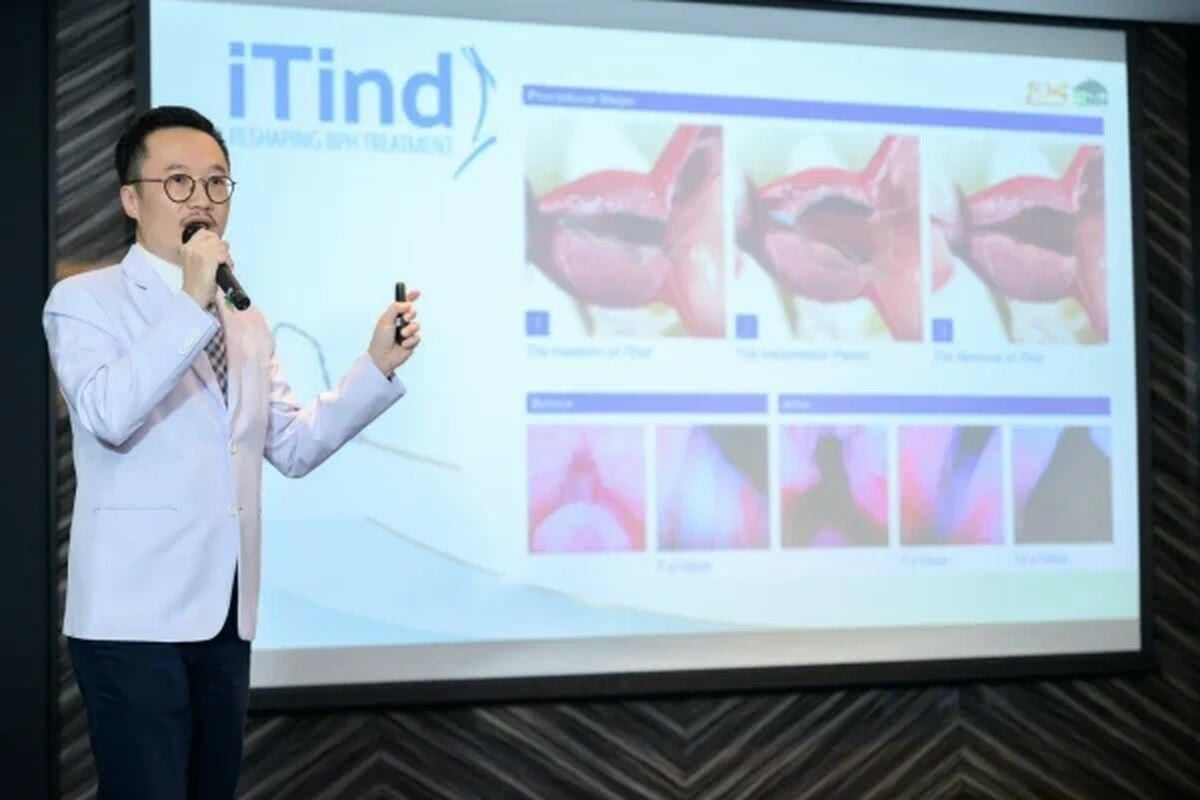iTind at M Centre, BNH Hospital Bangkok: The newest minimally invasive treatment for BPH

If you’ve been exploring treatment options for your enlarged prostate or benign prostatic hyperplasia (BPH), iTind at BNH Hospital Bangkok could be the answer you’ve been looking for. iTind is the newest minimally invasive treatment for BPH, and BNH Hospital is leading the way in Southeast Asia by introducing this procedure.
According to Dr Suntchai Wirotsaengthong, the lead urologist in M Centre, BNH Hospital Bangkok, the reason his team tried their best to bring iTind to patients in Thailand is that it addresses all BPH patients’ pain points. Not only can iTind relieve symptoms of an enlarged prostate, but it also offers fewer side effects compared to long-term medication and surgery in terms of preserving sexual functions and restoring patients overall quality of life. One of the good things that make patients tend to choose iTind instead of other treatments is that after the procedure they can go home without a catheter.
But what exactly is iTind? What are its benefits? Who is it for? And where you can find it in Bangkok? Keep reading to find out!
Everything you need to know about iTind

What is iTind?
The iTind (Temporarily Implanted Nitinol Device) is a device that gently reshapes the urethra, creating a wider opening for urine to flow freely. With this device, no burning or cutting tissue is required, and no permanent implant is left behind.
The procedure is divided into two parts. The first part is the insertion of the iTind, which will be performed in an operating room. A BNH Hospital urologist will use a small tube with a camera to assess the prostatic urethra and determine the optimal placement for the iTind. After that, the urologist will place the iTind in a folded configuration. Following the procedure, patients can typically return home within a few hours after passing urine.
iTind is becoming a favorite among BPH patients since it’s a catheter-free procedure. However, in cases where urination is challenging post-procedure, a temporary catheter may be inserted to alleviate bladder discomfort. This catheter will be removed after several hours, and patients will be able to go home.
The iTind device gradually expands over a period of 5 to 7 days, applying gentle pressure at three specific points to widen the passage for urine to flow through the prostatic urethra and exit the body. Subsequently, you need to visit BNH Hospital after 5 to 7 days for the second part of the procedure. This phase involves the removal of the iTind device using a flexible silicone catheter. Your urologist will numb the area before the procedure so you won’t feel anything.
What are the benefits of iTind?
One of the main benefits of iTind is that it requires almost no downtime. Since it’s a minimally invasive and outpatient-based treatment, you don’t need to be hospitalized. Plus, no general anesthesia is required; only light sedation is necessary. After the removal, you can resume regular activities within 1 to 2 days.
You can start to feel relief from symptoms as soon as the device has been removed, with ongoing improvement typically seen over the following 6 to 12 weeks. Moreover, iTind provides long-lasting results. Studies have shown durability for up to three years in terms of symptom relief, urinary flow improvement, and overall quality of life for a significant number of patients. Plus, the treatment improves sexual and ejaculatory function.
Edward Anderson, a 66-year-old man who underwent iTind at BNH Hospital, struggled with BPH and its symptoms for 10 long years. Despite initial concerns about iTind’s side effects and recovery process, Anderson was able to sleep soundly a couple of months after the procedure. He also declared that it changed his life.
“Around the second month after the procedure, I began noticing a subtle reduction in trips the bathroom at night. By the end of month three, I was waking on average one time a night to pee, which represents a dramatic improvement. For the first time in a very long time, I am now sleeping soundly through the night. My thanks to Dr. Suntchai, his team, and to BNH for pioneering this treatment in Bangkok. It has changed my life,” says Anderson.
Who is iTind for?
iTind is typically recommended for men who are experiencing mild to moderate BPH with a prostate volume of less than 80 ml. And since no general anesthesia is required, it’s an excellent option for men with chronic medical conditions that prevent them from having general anesthesia.
Is iTind a safe procedure?
iTind is safe and has been approved by the US FDA. Since it is the newest minimally invasive treatment for BPH, it received its US FDA very recently in 2020. It’s also included in the American Urological Association (AUA) guidelines for enlarged prostate treatment since 2023.
So, should you get iTind?
If you’ve been struggling with an enlarged prostate for a while, then iTind might be the solution you’ve been looking for to alleviate your symptoms and preserve your sexual functions. Not sure if it’s the right option for you? Schedule a free consultation with Dr Suntchai Wirotsaengthong at M Centre, BNH Hospital. BNH is the first hospital in Asia and to date, it is still the only one officially to provide iTind for BPH patients.
For more information about iTind and to schedule your free consultation with Dr Suntchai Wirotsaengthong, don’t hesitate to get in touch with him via WhatsApp at +66 63 4457854 or email dr.suntchai@mcentrebybnh.org.
Sponsored
Latest Thailand News
Follow The Thaiger on Google News:


























